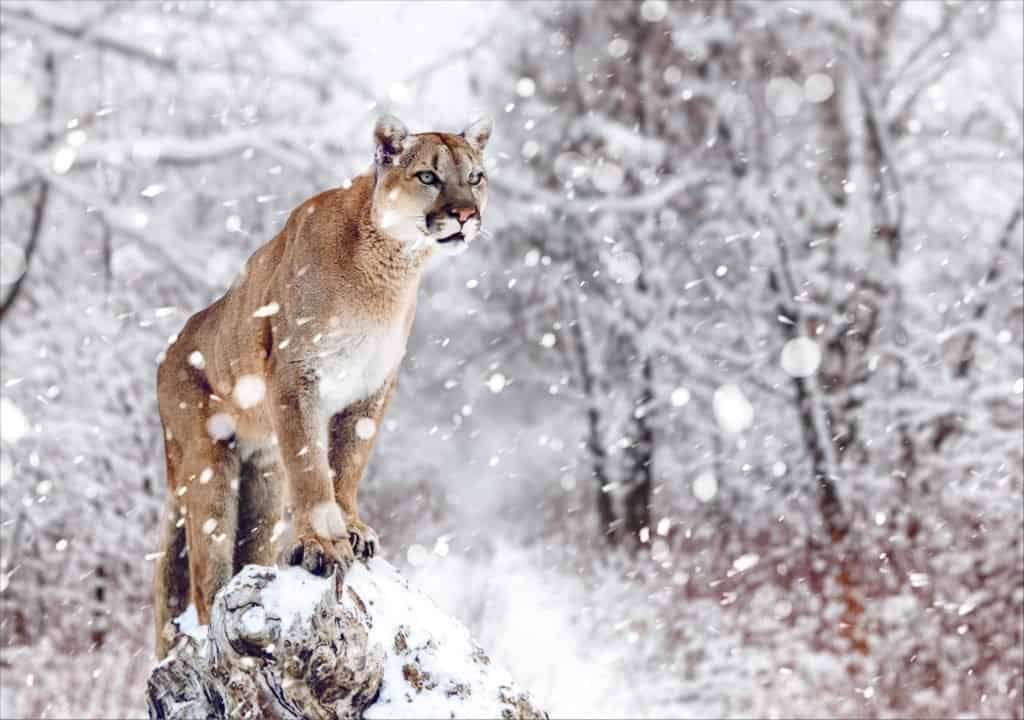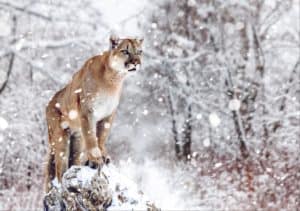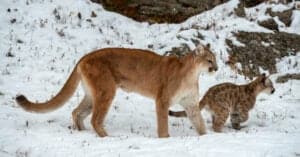Mountain Lion (Cougar) Population by State
@media (min-width: 481px) {
.mobile-top-content {
display: none;
}
}
#mobileTopContentCTACarouselControls { overflow: hidden; text-overflow: ellipsis; white-space: nowrap; }
.mobile-top-content .more { color: #fff; }
.mobile-top-content a { color: #fff; text-decoration: underline; }
.mobile-top-content a:hover { color: #fff; text-decoration: underline; }
@media (max-width: 480px) {
.mobile-top-content {
background-color: #06a10b;
color: #fff;
text-align: center;
/*height: 60px;
padding-top:5px;*/
font-size:80%;
/* display: block; */
margin: 0px -30px;
}
}
Key Points:
- Mountain lions are often referred to as pumas, panthers, or cougars depending on geographical location.
- The big cats are native to North America
- There are around 30,000 mountain lions speculated to live in the United States, distributed across the country.
Mountain lions are beautiful, graceful predators who hunt by night. How many of them live in the United States? We’ve done the research and gathered the facts. Here is the mountain lion population by state.
Meet the Mountain Lion
The mountain lion (Puma concolor) is also known as the cougar, panther, or puma. The cougar is one of the big cat species native to North America. Some people call it “America’s lion.”
The mountain lion is a large, slender cat whose coat ranges from tawny yellow to dark brown. It is a fierce, agile predator that has adapted well to many different environments. Mountain lions are found in mountains, coniferous forests, grasslands, swamps, and dry scrublands.

Unknown/Shutterstock.com
Origin
Since the humans were crossing the land bridge from Asia some 40,000 years ago, mountain lions were roaming the Americas, throughout the various countries of North and South. The big cats originated from a common ancestor shared with the African cheetah and American jaguarundi.
Where do mountain lions live?
They have an extensive range and are the most widespread of any living mammal in the Americas. In the United States, however, their population was decimated by decades of extensive hunting. Hunting bans and conservation efforts helped mountain lions regain some of their former territories. There are no resident populations in the eastern U.S., but these states may see cats who are passing through.
What do they eat?
The mountain lion is a fierce, nocturnal predator who can run, climb, and even swim when chasing prey. They eat:
What is the mountain lion population by state?
The total mountain lion population in the United States is estimated at 20,000 to 30,000.
It is difficult to count specific numbers of mountain lions because these cats are mobile and solitary. Some stay and breed in certain areas, but others travel long distances to find their prey. They’re also secretive, nocturnal, and excellent at avoiding humans.
A state can only be classified as having a particular species if it has an active, breeding, and self-sustaining wild population of cougars. That is only true of some states. Mountain lions may be spotted in other states, but they are just passing through on the hunt for prey.
For this article, we listed states that have active, breeding populations of mountain lions and those that occasionally see traveling cougars. For our information, we relied on official numbers from each state’s Fish and Wildlife Service, Department of Natural Resources, or another source.
MOUNTAIN LION POPULATION BY STATE
Alaska: Unconfirmed sightings
Officials with Alaska’s Department of Fish and Game regularly hear about mountain lion sightings, but there have not yet been any confirmed sightings. In the most recent sighting, the cat in question turned out to be a lynx. At this point, there’s no proof of transient or resident mountain lions in Alaska.
Arizona: 2,000 to 3,000
Arizona has a stable population of mountain lions. They tend to live in mountainous areas and rocky hills. The state allows controlled hunting of them. Under the law, hunters can’t kill females with kittens. The Department of Game and Fish says, “The population is stable to increasing in many parts of the state.”
Arkansas: 30
Mountain lions may be on their way back to Arkansas. There may be as many as 30 resident mountain lions in the state.
California: 4,000 to 6,000
California has one of the largest mountain lion populations in the country. The state classed mountain lions as endangered in 1972 and banned all hunting of them. The 2020 wildfires that ravaged California also affected mountain lion populations, killing an estimated 300 to 600 of them. Conservation groups and the state government have focused their efforts on ensuring the survival of mountain lions in California.
Colorado: 3,000 to 7,000
The mountains of Colorado are the perfect habitat for these nimble hunters. The state’s dense forests, rocky terrain, and abundant wildlife offer many hiding places and lots of prey for food. As the state’s Parks and Wildlife Department notes, “Colorado is prime mountain lion country.”
Florida: 120 to 230
Florida is home to an endemic subspecies of the mountain lion known as the Florida panther (Puma concolor coryi). It is the only mountain lion species with a breeding population in the eastern part of the U.S. It is the official state animal of Florida.
Florida panthers are a threatened species, but there is hope for their survival. According to the Nature Conservancy, there were only about 20 Florida panthers in 1973, and there are now more than 200. In 2017, the state enclosed more than 3,000 acres of Florida panther habitat that will remain permanently protected.
Idaho: 2,000
Mountain lions are widespread in the state. The Idaho Department of Fish and Game allows controlled hunting of mountain lions in specific situations. The law forbids killing cubs or females with young cubs. It is also illegal to trap, snare, or capture them. However, the Mountain Lion Foundation argues that Idaho has the most liberal mountain hunting laws of all the western states. It believes the annual hunting limits of 400 to 600 are too high given the population of only 2,000.
Illinois: Confirmed sightings
There have been confirmed sightings of mountain lions passing through Illinois on their way to another state.
Iowa: Confirmed sightings
People have spotted cougars making their way through the state.
Kansas: Confirmed sightings
People have seen cougars in Kansas.
Michigan: Increase in confirmed sightings
The Michigan Department of Natural Resources confirmed 10 cougar sightings in the state in 2021. All were in the Upper Peninsula. This continues an increase in confirmed sightings over several years. However, biologists have not been able to confirm that there are any breeding populations.
Minnesota: Confirmed sightings
Like Michigan, Minnesota has seen an increase in confirmed sightings but no sign of a resident population.
Missouri: Confirmed sightings
Missouri’s mountain lions were extirpated in 1923, but cougars pass through the state on their travels.
Montana: 2,111 to 3,258
Montana’s mountain lions are found all over the state. The state Fish, Wildlife, and Parks Department estimates that more than half the state is suitable mountain lion habitat. This is mostly in the western and central regions. Montana, like other western states, allows controlled, restricted hunting of mountain lions.
Nebraska: Confirmed sightings
Like other midwestern states, Nebraska has seen an uptick in confirmed cougar sightings, but it does not have a resident population.
Nevada: 2,000
As Nevada’s apex predator, the mountain lion enjoys a healthy, stable population in the state. These big cats are present in all of Nevada’s mountain areas and are protected by state law. They control rodent and deer populations and are considered keystones of their ecosystems.
New Mexico: 3,500
New Mexico’s cougars live in the rugged, hilly areas of the state. They are protected by state law. Because the state also protects bighorn sheep, however, it allows controlled hunting. The hunting is designed to allow both these species to thrive in New Mexico’s hills.
New York: Confirmed sightings
New York has had transient cougars passing through.
North Dakota: Confirmed sightings
There are 20 to 30 confirmed sightings each year.
Oklahoma: Confirmed sightings
The state has documented cougar sightings, but there are no confirmed breeding areas.
Oregon: 6,000
Mountain lions are native to Oregon, and their population is thriving. Despite this, human encounters with these secretive, nocturnal animals are rare. The cougar population in Oregon is considered healthy and at sustainable levels. Oregon allows controlled hunting of cougars.
South Dakota: 200 to 300
South Dakota successfully reintroduced mountain lions in recent years. Since then, it has seen its population grow to a small but steady 200 to 300 cougars.
Tennessee: Confirmed sightings
Tennessee has had a handful of confirmed sightings.
Texas: Unknown
Although there is a breeding population in the western part of the state, wildlife biologists are not certain how many mountain lions live in Texas. They live in the western region, Trans-Pecos region, and southern Texas. Wildlife officials say they have evidence that the population is growing, but exact numbers are not known.
Utah: 2,500
Utah’s mountainous areas and swamps are home to cougars. They have been spotted in Bryce Canyon and Zion National Park. Many visitors to the state’s parks are eager to see cougars or cougar tracks, but human encounters are rare. The state allows restricted hunting of cougars.
Vermont: 0
Like Alaska, Vermont is a state where many residents report cougar sightings. State wildlife biologists say these usually turn out to be bobcats.
Washington: 1,500
Washington’s mountain lions live all over the state except for a small area around the Columbia River Basin. They live in the Cascade Mountains and are an important predator in the state’s ecosystems. In 1996, Washington passed a law banning the use of hounds to hunt mountain lions.
Wisconsin: Confirmed sightings
There have been some confirmed sightings of cougars. State wildlife officials believe these mountain lions have crossed over from a population group living in the Black Hills of South Dakota.
Wyoming: 2,000
The population has been stable for decades, but in recent years, it has dropped. This is caused by many things, and it has led to some debate about Wyoming’s hunting policy. Wyoming citizens have urged the Fish and Game Commission to reduce hunting permits until the population is stable.
Up Next…
Wondering what other animals may be roaming around your neighborhood? Check out these articles:
- Black Bear Population by State – Black bears are relatively harmless to humans. See if you live near any!
- Alligator Population By State – Luckily, alligators are mainly found in warm, tropical areas.
- Copperhead Population By State – A not-so-pleasant snake to encounter, see where to be on the lookout for these guys.
FAQs (Frequently Asked Questions)
Which states have the most mountain lions?
• California: 4,000 to 6,000
• Colorado: 3,00 to 7,000
• Oregon: 6,000
More from A-Z Animals
.more-snake-card-image { max-height:140px !important; }
@media (min-width: 481px) {
.mobile-top-content {
display: none;
}
}
#mobileTopContentCTACarouselControls { overflow: hidden; text-overflow: ellipsis; white-space: nowrap; }
.mobile-top-content .more { color: #fff; }
.mobile-top-content a { color: #fff; text-decoration: underline; }
.mobile-top-content a:hover { color: #fff; text-decoration: underline; }
@media (max-width: 480px) {
.mobile-top-content {
background-color: #06a10b;
color: #fff;
text-align: center;
/*height: 60px;
padding-top:5px;*/
font-size:80%;
/* display: block; */
margin: 0px -30px;
}
}
Key Points:
- Mountain lions are often referred to as pumas, panthers, or cougars depending on geographical location.
- The big cats are native to North America
- There are around 30,000 mountain lions speculated to live in the United States, distributed across the country.
Mountain lions are beautiful, graceful predators who hunt by night. How many of them live in the United States? We’ve done the research and gathered the facts. Here is the mountain lion population by state.
Meet the Mountain Lion
The mountain lion (Puma concolor) is also known as the cougar, panther, or puma. The cougar is one of the big cat species native to North America. Some people call it “America’s lion.”
The mountain lion is a large, slender cat whose coat ranges from tawny yellow to dark brown. It is a fierce, agile predator that has adapted well to many different environments. Mountain lions are found in mountains, coniferous forests, grasslands, swamps, and dry scrublands.

Unknown/Shutterstock.com
Origin
Since the humans were crossing the land bridge from Asia some 40,000 years ago, mountain lions were roaming the Americas, throughout the various countries of North and South. The big cats originated from a common ancestor shared with the African cheetah and American jaguarundi.
Where do mountain lions live?
They have an extensive range and are the most widespread of any living mammal in the Americas. In the United States, however, their population was decimated by decades of extensive hunting. Hunting bans and conservation efforts helped mountain lions regain some of their former territories. There are no resident populations in the eastern U.S., but these states may see cats who are passing through.
What do they eat?
The mountain lion is a fierce, nocturnal predator who can run, climb, and even swim when chasing prey. They eat:
What is the mountain lion population by state?
The total mountain lion population in the United States is estimated at 20,000 to 30,000.
It is difficult to count specific numbers of mountain lions because these cats are mobile and solitary. Some stay and breed in certain areas, but others travel long distances to find their prey. They’re also secretive, nocturnal, and excellent at avoiding humans.
A state can only be classified as having a particular species if it has an active, breeding, and self-sustaining wild population of cougars. That is only true of some states. Mountain lions may be spotted in other states, but they are just passing through on the hunt for prey.
For this article, we listed states that have active, breeding populations of mountain lions and those that occasionally see traveling cougars. For our information, we relied on official numbers from each state’s Fish and Wildlife Service, Department of Natural Resources, or another source.
MOUNTAIN LION POPULATION BY STATE
Alaska: Unconfirmed sightings
Officials with Alaska’s Department of Fish and Game regularly hear about mountain lion sightings, but there have not yet been any confirmed sightings. In the most recent sighting, the cat in question turned out to be a lynx. At this point, there’s no proof of transient or resident mountain lions in Alaska.
Arizona: 2,000 to 3,000
Arizona has a stable population of mountain lions. They tend to live in mountainous areas and rocky hills. The state allows controlled hunting of them. Under the law, hunters can’t kill females with kittens. The Department of Game and Fish says, “The population is stable to increasing in many parts of the state.”
Arkansas: 30
Mountain lions may be on their way back to Arkansas. There may be as many as 30 resident mountain lions in the state.
California: 4,000 to 6,000
California has one of the largest mountain lion populations in the country. The state classed mountain lions as endangered in 1972 and banned all hunting of them. The 2020 wildfires that ravaged California also affected mountain lion populations, killing an estimated 300 to 600 of them. Conservation groups and the state government have focused their efforts on ensuring the survival of mountain lions in California.
Colorado: 3,000 to 7,000
The mountains of Colorado are the perfect habitat for these nimble hunters. The state’s dense forests, rocky terrain, and abundant wildlife offer many hiding places and lots of prey for food. As the state’s Parks and Wildlife Department notes, “Colorado is prime mountain lion country.”
Florida: 120 to 230
Florida is home to an endemic subspecies of the mountain lion known as the Florida panther (Puma concolor coryi). It is the only mountain lion species with a breeding population in the eastern part of the U.S. It is the official state animal of Florida.
Florida panthers are a threatened species, but there is hope for their survival. According to the Nature Conservancy, there were only about 20 Florida panthers in 1973, and there are now more than 200. In 2017, the state enclosed more than 3,000 acres of Florida panther habitat that will remain permanently protected.
Idaho: 2,000
Mountain lions are widespread in the state. The Idaho Department of Fish and Game allows controlled hunting of mountain lions in specific situations. The law forbids killing cubs or females with young cubs. It is also illegal to trap, snare, or capture them. However, the Mountain Lion Foundation argues that Idaho has the most liberal mountain hunting laws of all the western states. It believes the annual hunting limits of 400 to 600 are too high given the population of only 2,000.
Illinois: Confirmed sightings
There have been confirmed sightings of mountain lions passing through Illinois on their way to another state.
Iowa: Confirmed sightings
People have spotted cougars making their way through the state.
Kansas: Confirmed sightings
People have seen cougars in Kansas.
Michigan: Increase in confirmed sightings
The Michigan Department of Natural Resources confirmed 10 cougar sightings in the state in 2021. All were in the Upper Peninsula. This continues an increase in confirmed sightings over several years. However, biologists have not been able to confirm that there are any breeding populations.
Minnesota: Confirmed sightings
Like Michigan, Minnesota has seen an increase in confirmed sightings but no sign of a resident population.
Missouri: Confirmed sightings
Missouri’s mountain lions were extirpated in 1923, but cougars pass through the state on their travels.
Montana: 2,111 to 3,258
Montana’s mountain lions are found all over the state. The state Fish, Wildlife, and Parks Department estimates that more than half the state is suitable mountain lion habitat. This is mostly in the western and central regions. Montana, like other western states, allows controlled, restricted hunting of mountain lions.
Nebraska: Confirmed sightings
Like other midwestern states, Nebraska has seen an uptick in confirmed cougar sightings, but it does not have a resident population.
Nevada: 2,000
As Nevada’s apex predator, the mountain lion enjoys a healthy, stable population in the state. These big cats are present in all of Nevada’s mountain areas and are protected by state law. They control rodent and deer populations and are considered keystones of their ecosystems.
New Mexico: 3,500
New Mexico’s cougars live in the rugged, hilly areas of the state. They are protected by state law. Because the state also protects bighorn sheep, however, it allows controlled hunting. The hunting is designed to allow both these species to thrive in New Mexico’s hills.
New York: Confirmed sightings
New York has had transient cougars passing through.
North Dakota: Confirmed sightings
There are 20 to 30 confirmed sightings each year.
Oklahoma: Confirmed sightings
The state has documented cougar sightings, but there are no confirmed breeding areas.
Oregon: 6,000
Mountain lions are native to Oregon, and their population is thriving. Despite this, human encounters with these secretive, nocturnal animals are rare. The cougar population in Oregon is considered healthy and at sustainable levels. Oregon allows controlled hunting of cougars.
South Dakota: 200 to 300
South Dakota successfully reintroduced mountain lions in recent years. Since then, it has seen its population grow to a small but steady 200 to 300 cougars.
Tennessee: Confirmed sightings
Tennessee has had a handful of confirmed sightings.
Texas: Unknown
Although there is a breeding population in the western part of the state, wildlife biologists are not certain how many mountain lions live in Texas. They live in the western region, Trans-Pecos region, and southern Texas. Wildlife officials say they have evidence that the population is growing, but exact numbers are not known.
Utah: 2,500
Utah’s mountainous areas and swamps are home to cougars. They have been spotted in Bryce Canyon and Zion National Park. Many visitors to the state’s parks are eager to see cougars or cougar tracks, but human encounters are rare. The state allows restricted hunting of cougars.
Vermont: 0
Like Alaska, Vermont is a state where many residents report cougar sightings. State wildlife biologists say these usually turn out to be bobcats.
Washington: 1,500
Washington’s mountain lions live all over the state except for a small area around the Columbia River Basin. They live in the Cascade Mountains and are an important predator in the state’s ecosystems. In 1996, Washington passed a law banning the use of hounds to hunt mountain lions.
Wisconsin: Confirmed sightings
There have been some confirmed sightings of cougars. State wildlife officials believe these mountain lions have crossed over from a population group living in the Black Hills of South Dakota.
Wyoming: 2,000
The population has been stable for decades, but in recent years, it has dropped. This is caused by many things, and it has led to some debate about Wyoming’s hunting policy. Wyoming citizens have urged the Fish and Game Commission to reduce hunting permits until the population is stable.
Up Next…
Wondering what other animals may be roaming around your neighborhood? Check out these articles:
- Black Bear Population by State – Black bears are relatively harmless to humans. See if you live near any!
- Alligator Population By State – Luckily, alligators are mainly found in warm, tropical areas.
- Copperhead Population By State – A not-so-pleasant snake to encounter, see where to be on the lookout for these guys.





